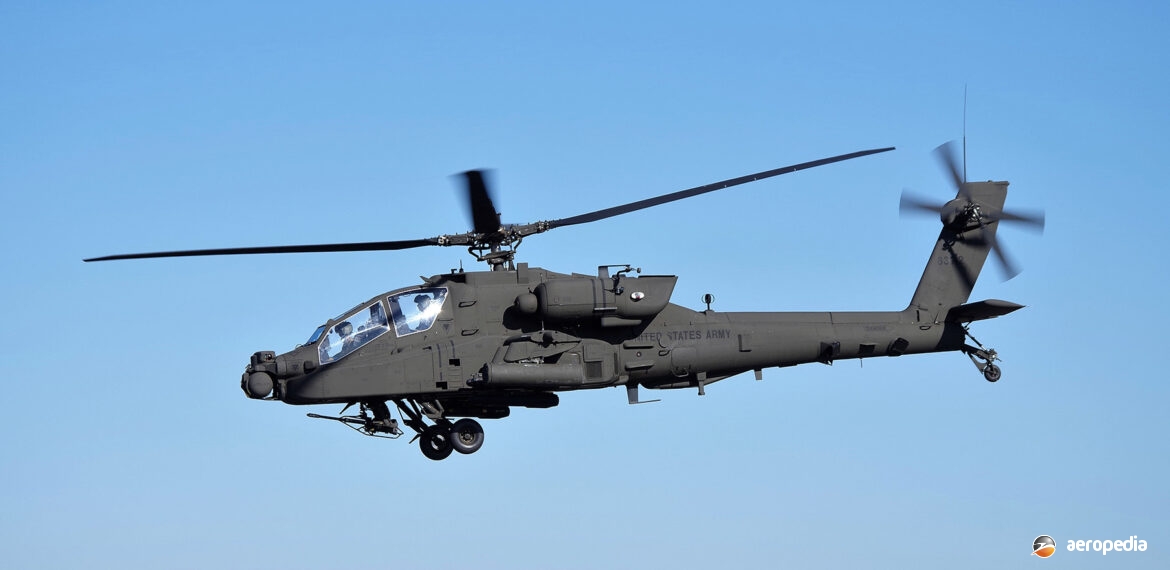Photograph:
Boeing AH-64D 63112 at the Australian International Air Show at Avalon, Vic in March 2017
Country of origin:
United States of America
Description:
Military attack helicopter
Power Plant:
Two 1,410 kw (1,890 shp) General Electric T700-GE-701C turboshaft engines
Specifications:
- Main rotor diameter: 14.63 m (48 ft)
- Main rotor area: 177.3² (1,908.5 sq ft)
- Fuselage length: 15.06 m (49 ft 5 in)
- Overall length: 17.73 m (58 ft 2 in)
- Height: 3.87m (12 ft 8 in)
- Never exceed speed: 365 km/h (227 mph)
- Max speed: 293 km/h (182 mph)
- Cruising speed: 265 km/h (227 mph)
- Service ceiling: 6,100 m (20,000 ft)
- Vertical rate of climb: 541 m/min (1,775 ft/min)
- Combat range: 480 km (300 miles)
- Ferry range: 1,896 km (1,178 miles)
- Empty weight: 5,165 kg (11,387 lb)
- Loaded weight: 8,006 kg (17,650 lb)
- Max take-off weight: 10,433 kg (23,000 lb)
Armament:
One 30-mm (1.18 in) M239 Chain Gun with 1,200 rounds; four pylons on the stub wings; Hydra 70 70 mm CRV7 70 mm and APKWS 70 mm air-to-ground rockets. AGM-114 Hellfire missile; AIM-92 Stinger and Spike missiles.
History:
On 15 January 2021 to meet Project Land Requirement 4503 the Australian Government ordered 29 examples of the Boeing AH-64E Apache Guardian to replace the the troublesome Eurocopter Tiger attack helicopter with the Australian Army. Entry of the AH-64E into Australian Army service is expected to take place in 2026.
As compared to the AH-64D the AH-64E Apache Guardian featured an improved digital connectivity system, a Joint Tactical Information Distribution System and more powerful General Electric T700-GE-701D engines providing 1,500 kw (2,000 shp) with an upgraded transmission to deal with the extra power, a capability to deal with unmanned aerial vehicles (UAV), full IFR capability, a modified undercarriage and new composite rotor blades. It is 32 km/ (20 mph) faster, better fuel efficiency, increased time on station from 2.5 hrs to 3 hours.
The first AH-64E was completed in 2004 and has increased speed, rate of climb and payload capacity. Production of new build AH-64Es commenced in 2019 and a number of AH-64Ds are to be upgraded to AH-64E standard.
In the 1970s Hughes Helicopters developed an advanced attack helicopter to meet the United States Army’s requirements. The prototype, known as the Model 77, became the YAH-64 and was first flown on 30 September 1975. It was then flown off in a competition against the Bell YAH-63, the former being the winner. In 1984 Hughes Helicopters was obtained by McDonnell Douglas and the AH-64 entered production, being introduced to service in April 1986. Later it was taken over by Boeing Defense and by June 2020 the Company announced it had delivered the 2,500th AH-64.
The US Army required a helicopter with better performance, firepower, performance and range than the Bell AH-1 Cobra. In 1972 the US Army issued a Request for Proposals for an advanced Attack Helicopter (AAH). The AH-64 series has been sold to a number of military arms around the world and has been built in the United Kingdom under licence as the Agusta Westland Apache, being known s the WAH-64D, these machines being fitted with the 1,600 kw (2,100 shp) Rolls Royce Turbomeca RTM322 engines, being known as the AH-1 by the British Army. Three pre-production were used by the US Army for Operational Test II. It was named Apache in 1981and approved for full production in 1982.Over the years development has continued to up-dating the cockpit, new fire control systems and various upgrades. The AH-64D Apache Longbow prototype first flew on 15 April 1992 with full production was approved in October 1995.
The airframe of the Apache has 1,100 kg (2,500 lb) of protection for the crew including between the cockpits so the crew members can survive enemy fire. It was designed to meet minimum crashworthiness requirements. One of the features used by the crew is the helmet mounted display, known as the IHADSS (Integrated Helmet and Display Sighting System). The pilot or gunner can both use the 30 mm automatic M230 Chain Gun via the helmet.
The type was designed to operate on the front-line to operate night or day in adverse weather. System include a Target Acquisition and Designator System, Pilot Night Vision System, GPS and infrared countermeasures. The type has regularly operated in conjunction with the Fairchild A-10 Thunderbolt II of the United States Air Force and the United States Marine Corps McDonnell Douglas AV-8B Harrier II acting as a target designator.
The AH-64 first saw operational use in 1989 during Operation Just Cause being the invasion of Panama. In 1991 it operated during operation Desert Storm and destroyed part of the Iraw radar network in the first attack. It was also involved in the conflicts in Bosnia and Kosovo in the 1990s and operation Enduring Freedom in Afghanistan in 2001.
In February 2023 an American army Apah was in Australi for the International Airhow atAvalon, VIC and at the time he Ausralian Defence Force trialled the machine on HMAS Canberra berthed at Garden Island in Sydney, trials commencing on 22 February and th AH-64Es for the Australian Army were expected to be fully operational with a full complement of mahines by 2028.

